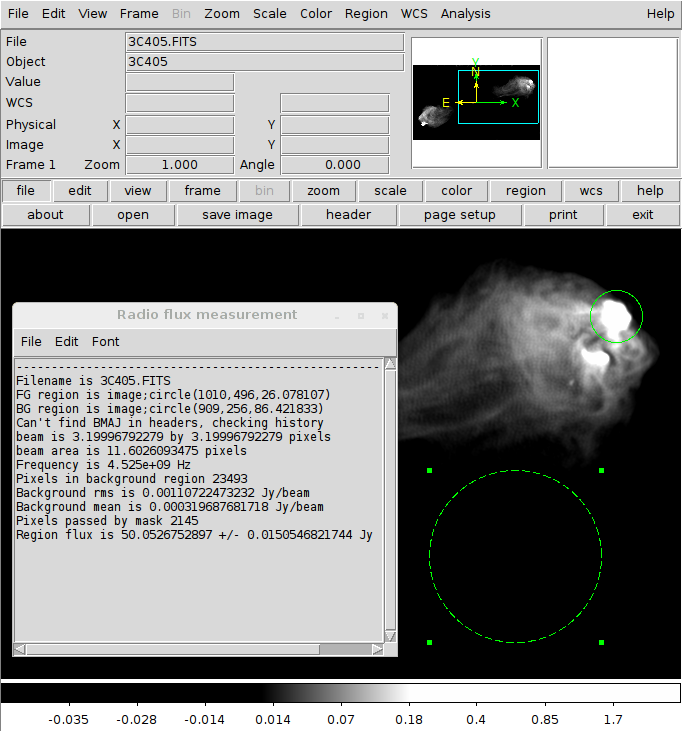Radio flux measurements with ds9
 ds9 is a popular FITS
viewer which can be used to define complex regions on an image.
This page shows you how to install a plugin to allow flux density from
radio maps to be measured in ds9, without needing to install AIPS,
Casa or other radio astronomy software.
ds9 is a popular FITS
viewer which can be used to define complex regions on an image.
This page shows you how to install a plugin to allow flux density from
radio maps to be measured in ds9, without needing to install AIPS,
Casa or other radio astronomy software.
Pre-requisites
The currently distributed version of the plugin is written in python
and uses
the numpy, scipy, astropy
and pyregion
packages. You need to install these (and ds9, if you don't have it)
before installing the plugin. Most python users will already have
numpy and many astronomers will already have astropy installed.
If you have the python distribution tool pip, then you can
sudo pip install astropy
sudo pip install pyregion
Building the plugin
Download a stable version of the
plugin here,
or clone the git
repository here.
(Note, I recommend using github if you are confident in doing so
— the latest version will normally be the best.)
Either way, go into the top-level directory and do
sudo python setup.py install
Note the location in which the installer places
the radio-flux.ds9 file.
As of version 1.2, you may find that
sudo pip install --egg radioflux
works as well and doesn't require you to manually download the code,
but if it doesn't, use one of the methods described above.
Integration with ds9
Start up ds9 and load the code as analysis commands with Analysis -> Load Analysis
Commands, pointing to the radio-flux.ds9 file. (If you want
it loaded automatically when ds9 starts, you can set this up in Edit
-> Preferences.)
Using the plugin
Once the plugin loaded, you will see two new entries under the
Analysis menu: 'radio flux measurement' and 'radio flux measurement
(background subtraction)'.
For the simplest possible flux measurement, define a region, or a set
of regions, and choose 'radio flux measurement'. The code will measure
the flux density from all the selected regions and report the result
in a popup text box. Exclusion regions may be used to mask out parts
of the source you don't want to include.
If you define a background region or regions, these will be used to
estimate the off-source noise and the flux will be returned with an
error bar. (Usual caveats about the relationship between off-source
and on-source noise apply.) To define a background region, either
choose this property from Region -> Properties, or double-click on the
region and edit its properties.
Alternatively, you can use a background region to perform background
subtraction, using the second menu item. This subtracts the mean
surface brightness in the background region from that in the source
region when measuring the flux: useful if you are measuring a flux
density of a resolved structure superposed on a smooth background.
Note that in this case the error quoted will be derived from your
non-zero background region, so it may not be what you want!
The code reports several other properties of the image in the text
window and you may want to check these to verify that it's working correctly.
Stand-alone use
The module that provides the functionality for the ds9
plugin, radioflux.py, can also be run stand-alone, allowing
you to use saved ds9 region files on many FITS files simultaneously.
radioflux.py -f foreground.reg -b background.reg file1.fits file2.fits ...
The output here is a simple text list of files, frequencies, and flux
densities with errors.
Feedback
Comments on this page or (reasonable) requests for support are welcome — please e-mail me
at  . If you think you have found a bug
or want to make a request for enhancement, please do so
via GitHub.
. If you think you have found a bug
or want to make a request for enhancement, please do so
via GitHub.
 ds9 is a popular FITS
viewer which can be used to define complex regions on an image.
This page shows you how to install a plugin to allow flux density from
radio maps to be measured in ds9, without needing to install AIPS,
Casa or other radio astronomy software.
ds9 is a popular FITS
viewer which can be used to define complex regions on an image.
This page shows you how to install a plugin to allow flux density from
radio maps to be measured in ds9, without needing to install AIPS,
Casa or other radio astronomy software.
 . If you think you have found a bug
or want to make a request for enhancement, please do so
via GitHub.
. If you think you have found a bug
or want to make a request for enhancement, please do so
via GitHub.